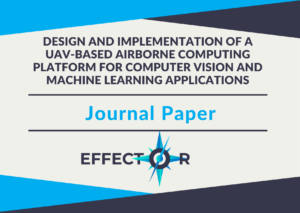 The EFFECTOR Journal paper entitled “Design and Implementation of a UAV-Based Airborne Computing Platform for Computer Vision and Machine Learning Applications” was officially published in MDPI’s sensors magazine on March 6th, 2022. The paper is under open access status and you can find it at: https://www.mdpi.com/1424-8220/22/5/2049
The EFFECTOR Journal paper entitled “Design and Implementation of a UAV-Based Airborne Computing Platform for Computer Vision and Machine Learning Applications” was officially published in MDPI’s sensors magazine on March 6th, 2022. The paper is under open access status and you can find it at: https://www.mdpi.com/1424-8220/22/5/2049
The paper was created by our partners from ICCS
DOI: https://doi.org/10.3390/s22052049
Design and Implementation of a UAV-Based Airborne Computing Platform for Computer Vision and Machine Learning Applications
Journal paper, Special Issue: UAV Imaging and Sensing
Abstract of the paper
Visual sensing of the environment is crucial for flying an unmanned aerial vehicle (UAV) and is a centerpiece of many related applications. The ability to run computer vision and machine learning algorithms onboard an unmanned aerial system (UAS) is becoming more of a necessity in an effort to alleviate the communication burden of high-resolution video streaming, to provide flying aids, such as obstacle avoidance and automated landing, and to create autonomous machines. Thus, there is a growing interest on the part of many researchers in developing and validating solutions that are suitable for deployment on a UAV system by following the general trend of edge processing and airborne computing, which transforms UAVs from moving sensors into intelligent nodes that are capable of local processing. In this paper, we present, in a rigorous way, the design and implementation of a 12.85 kg UAV system equipped with the necessary computational power and sensors to serve as a testbed for image processing and machine learning applications, explain the rationale behind our decisions, highlight selected implementation details, and showcase the usefulness of our system by providing an example of how a sample computer vision application can be deployed on our platform.
Keywords: UAV; onboard processing; airborne computing; machine learning; image processing; embedded system; testbed







